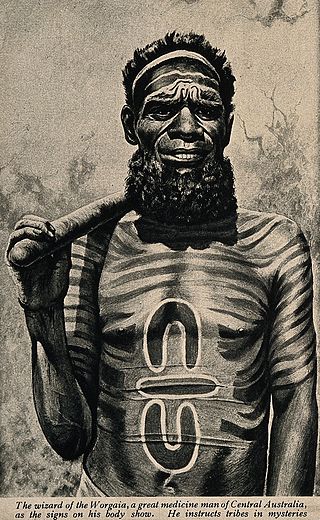Country
Norman Tindale's estimate in 1974 assigned to the Alyawarre traditional tribal lands extending over some 17,800 square miles (46,000 km2), taking in the Sandover and Bundey rivers, as well as Ooratippra, and Fraser creeks. Notable sites associated with their nomadic world include Mount Swan, northern flank of Harts Range, Plenty River north and west of Ilbala, Jervois Range, Mount Playford and the Elkedra River. They were also present at MacDonald Downs and Huckitta.
The Utopia community, 250 kilometres (160 mi) north-east of Alice Springs, is partly on Alyawarre land, partly on land of the Anmatyerre.

Emily Kame Kngwarreye was an Aboriginal Australian artist from the Utopia community in the Northern Territory. After only starting painting as a septuagenarian, Kngwarreye became one of the most prominent and successful artists in the history of Indigenous Australian art.
Gloria Petyarre, also known as Gloria Pitjara was born in 1942 in Utopia, Northern Territory, Australia. She was an Aboriginal Australian artist from the Anmatyerre community, just north of Alice Springs. One of her best known works is "Bush Medicine".
Minnie Pwerle was an Australian Aboriginal artist. She came from Utopia, Northern Territory, a cattle station in the Sandover area of Central Australia 300 kilometres (190 mi) northeast of Alice Springs.

Utopia, also known as Urapuntja and Amengernterneah, is an Aboriginal Australian homeland area formed in November 1978 by the amalgamation of the former Utopia pastoral lease, from which it gains its name, with a tract of unalienable land to its north. It covers an area of 3,500 km2 (1,400 sq mi), transected by the Sandover River, and lies on a traditional boundary of the Alyawarre and Anmatyerre people, the two Aboriginal language groups which predominate there today.
Kathleen Petyarre was an Australian Aboriginal artist. Her art refers directly to her country and her Dreamings. Petyarre's paintings have occasionally been compared to the works of American Abstract Expressionists Jackson Pollock and Mark Rothko, and even to those of J. M. W. Turner. She has won several awards and is considered one of the "most collectable artists in Australia". Her works are in great demand at auctions. Petyarre died on 24 November 2018, in Alice Springs, Australia.
The Warumungu are a group of Aboriginal Australians of the Northern Territory. Today, Warumungu are mainly concentrated in the region of Tennant Creek and Alice Springs.

Earth's Creation is a 1994 painting by the Australian Aboriginal artist Emily Kame Kngwarreye. It was painted in 1994 at Utopia, Northern Territory, north east of Alice Springs in central Australia.
Nancy Kunoth Petyarre was an Australian Aboriginal artist who lived in Utopia, 170 miles north east of Alice Springs. The second eldest of the famous and prolific 'seven famous Petyarre sisters' of Utopia, she was not herself a prolific artist.
The Anmatyerr, also spelt Anmatyerre, Anmatjera, Anmatjirra, Amatjere and other variations) are an Aboriginal Australian people of the Northern Territory, who speak one of the Upper Arrernte languages.
Kudditji Kngwarreye, also known as "Goob", was an Australian Aboriginal artist from the Utopia community in the Northern Territory. He was the brother through kinship of the late Emily Kame Kngwarreye. Like his skin sister Emily, he was one of the most prominent and successful artists in the history of contemporary indigenous Australian art.
The Atjinuri were an indigenous Australian people of the Cape York Peninsula of Queensland.

The Wakaya are an Aboriginal Australian people of the Northern Territory.
The Banbai are an Indigenous Australian people of New South Wales.
The Wirngir are an Aboriginal Australian people of the Kimberley region of Western Australia.
The Wangkangurru, also written Wongkanguru and Wangkanguru, are an Aboriginal Australian people of the Simpson Desert area in the state of South Australia. They also refer to themselves as Nharla.
The Yindjilandji are an indigenous Australian people of the Northern Territory.
The Gudanji, otherwise known as the Kotandji or Ngandji, are an indigenous Australian people of the Northern Territory.
The Mudburra, also spelt Mudbara and other variants, are an Aboriginal Australian people of the Northern Territory.
Margaret Scobie is an Australian Aboriginal artist from the Anmatyerre community, just north of Alice Springs.
Angelina Pwerle is an Australian Indigenous artist, born c. 1946 in the Utopia region of Central Australia. Her work is held by the Metropolitan Museum of Art, the National Gallery of Australia and others.
This page is based on this
Wikipedia article Text is available under the
CC BY-SA 4.0 license; additional terms may apply.
Images, videos and audio are available under their respective licenses.



